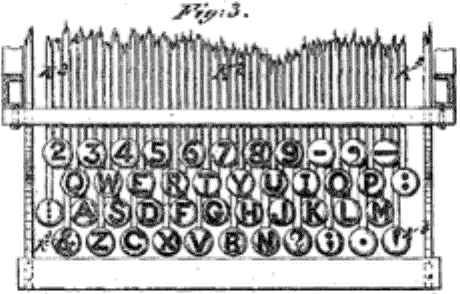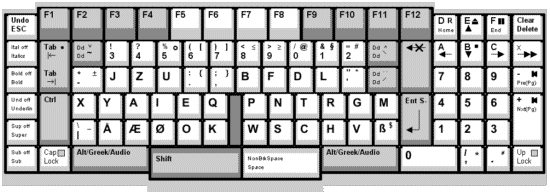Main Menu
Knowledgebase
Keyboard

Keyboard of the Future
The Qwerty-keyboard, which is used on almost all computer systems today, was patented by Christopher Latham Sholes August 27, 1878 (US patent
207,559).

The patent had 14 specific technical claims, but unfortunately none refer to the keys and layout, so it can only be guesswork why the keys are arranged the way they are. As the central letter-row has some alphabetical arrangement (--DFGHJKLM) and almost all vocals are located in the upper row, it is likely that the first prototype was arranged alphabetically with the vocals in the upper row and the consonants in the two lower rows (AEIOUY, BCDFGHJKLM, NPQRSTVWXZ). However, this layout may have coursed trouble with jam of the mechanical type bars and/or the eyes may have wandered too much from side to side when doing two-finger typing. As his assistant Amos Densmore had worked on statistics of letter pairs like "TH", it is likely that some keys were interchanged according to his work to avoid these problems and improve the efficiency so that all letters in letter pairs got as close to each other as they could get without coursing jam. The original layout had only upper-case letters, but the layout with the most used letters to the left were also very appropriate for later versions with lower-case letters because the heavy platen lifter (the one, which shift to capital letters) could then be operated with the rather slow left hand without moving the hand too much. The keyboard was fairly optimized for a mechanical typewriter and therefore became a success, but unfortunately it is hopeless for touch-typing because the most used keys must be operated with the left hand. In fact, thousands of English words can be spelled using only the left hand, while only a couple of hundred words can be typed using only the right hand.
With the Qwerty-keyboard, it is a tough struggle to learn touch-typing. The placement of the keys does not follow the natural movement of the
fingers, it is not immediately obvious which fingers operate which keys, and the most used letters are located a distance from the fastest fingers.
Often one starts by training F and J, even though these two letters together only make up approximately 2 % of the English language and 4 % of Danish!
As a comparison, the two most used letters - E and T - together make up approximately 21 % of English and 24 % of Danish. The tough struggle is
the reason why so few people utilize the big rationalization and health gain of touch-typing, and many never get really fast even when they have
learned it. You may wonder why business managers, who daily speak about efficiency and rationalization and spend a lot of money on health
insurance, can allow that there staff use such a keyboard.
As an inventor company specialized in efficient solutions, we "of course" cannot watch this level of inefficiency without suggesting a better
alternative so here is our preliminary suggestion for the keyboard of the future:

The keyboard is based on the following ideas:
- The keys should follow the natural movement of the fingers without being exaggerated located.
- The most used letters should be located directly under the fastest fingers.
- The keys should be located; so that the most used letter combinations may be stroked in a rolling motion from the center and outwards, as this is the absolute fastest way of typing. This includes common combinations like STR, SCH, SCR, NT, ND, NG, TR, TH, BL, BR, PL, PR, PH, WR, WH, FL, FR, EI, EA, EU, QU and the French D' and L'.
- Because all languages primary consist of alternately vowels and consonants and there are more consonants than vowels, the keys should be arranged in such a way that the vowels lie to the left (the slow side) and the consonants to the right. This enables an alternate left/right motion, which is known from the two-finger typing, and is the next fastest way of typing.
- The keyboard should be well suited for both touch-typing and two-finger typing, and you should almost automatically learn touch-typing just by using the keyboard. To facilitate two-finger typing, the distance between the most used vowels (primary E) and consonants should be reduced as much as possible.
- The letters should be located so that the little fingers are used as little as possible.
- Shift to capital letters and upper case should be done by the thumbs instead of the little fingers. It should be possible to use both right and left thumb.
- There should only be one type of "Alt" key, which should change the letters to greek letters with both lower case and upper case. "Alt Gr" is a left from the old DOS days without pixel graphics.
- The keyboard should be suitable for international use - not only optimized for one language. Most of the keys should be the same for all countries and have the same positions. The number of country specific keys like the Danish Æ, Ø and Å should be reduced as much as possible.
- To prevent mouse injuries, the keyboard should be as narrow as possible so that the mouse can get very close to the main keyboard. This is much more important than having a separate group for cursor keys etc., which are rarely used.
- The keyboard layout should be suitable for all types of computer systems including labtop computers, tablets and smartphones.
- The keys should be lowered in the keyboard, so that a more relaxed resting position for the hand is obtained, and so that it is possible to lay a book or a file over the keyboard without activating or destroying the keys.
- The keyboard should include telephone keys, so that it may also be used for dialing phone numbers. In this way, the normal telephone could be replaced by a much less space-consuming receiver or headset.
- If a numeric keypad is present, it also ought to be easy to type hexadecimal numbers.
- The mostly used dead keys should be directly reachable as lower case.
- The keyboard must not be more expensive to produce than the Qwerty-keyboard.
Note that the Keyboard is only a first draft. For example, the numeric keypad will probably be removed in future versions to make even more space for a mouse.
This page is updated July 30th 2013